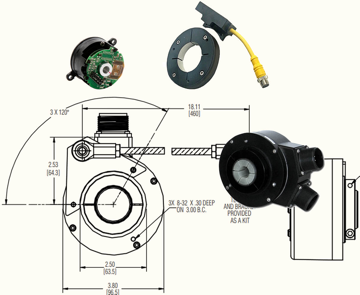Quadrature output refers to the phasing of the output signals. When the output signals, signal A and B, are 90 degrees out of phase with each other, the output is said to be in quadrature. This is the only thing that the term quadrature implies. (see What is a Quadrature output?)
x4 Logic denotes how the controller will interpret the signal that it is receiving. This is done by translating each edge of the pulse detected for the A and B channel into its own pulse. This translation takes place in the controller and not at the encoder.
This means if you order a quadrature encoder with 120 pulses per revolution, the output of signal A and B will be out of phase by 90 degrees. It does not mean that for every one revolution that the encoder makes you will get 480 pulses. The multiplication of the pulses only occurs at the controller
What is the Difference Between Quadrature and x4 Logic?
Posted by London Rhodes on May 24, 2021 1:42:15 PM
What is the Purpose of the A not and B not Channels?
Posted by London Rhodes on May 24, 2021 12:36:57 PM
The A not and B
Topics: Encoder Signals Output, Troubleshooting
What is the Difference Between Resolvers and Encoders?
Posted by London Rhodes on May 6, 2021 12:44:47 PM
What Equipment Is Used To Troubleshoot Encoders?
Posted by London Rhodes on Apr 28, 2021 2:27:02 PM
Topics: Encoder Signals Output, Troubleshooting
Why Do I Need a Pull-Up Resistor?
Posted by London Rhodes on Apr 19, 2021 12:30:19 PM
A pull up resistor is used to "pull" the logic high voltage level up to the level of the operating voltage. This is useful when the output of the Open Collector is not reaching the voltage level needed to indicate a logic high signal or when noise is present on the signal line. When a logic high signal is present its voltage level will be approx. that of the operating voltage for an open circuit. The difference is due to the voltage drop across the pull-up resistor. This is not necessarily true if the load is referenced to ground.
What is a Quadrature Output?
Posted by London Rhodes on Apr 19, 2021 11:41:49 AM
Quadrature output refers to the fact that the signals A and B are separated by 90 degrees of phase shift with A leading B or B leading A depending on the direction of rotation. It does not mean that the output will be 4 times the amount of the Pulses Per Revolution of the encoder. The fact that the signals are 90 degrees out of phase enables the controller to determine the direction that the encoder is spinning. You must use both the A and B signal to have a quadrature output and to get X2 or X4 logic. (see What is the difference between Quadrature and x4 Logic?)
What is a Push-Pull Output?
Posted by London Rhodes on Apr 16, 2021 1:30:01 PM
A Push-Pull output is an output that allows you to connect either a sinking or sourcing circuit. (see What is a Sinking or Sourcing input?) This type of an output allows you to sink more current than a Totem Pole output and follow the input voltage. A Push-Pull output is chosen when an Open Collector output will not work with the controller that is connected to the encoder.
Topics: Encoder Signals Output
What is a Totem Pole Output?
Posted by London Rhodes on Apr 16, 2021 10:44:04 AM
A Totem Pole output is essentially the same as a Push-Pull output; however, it is the terminology commonly used when referring to a TTL device. The major difference between it and a Push-Pull is the amount of current that it can sink or source. The Totem Pole output is going to sink/source less current then a Push-Pull output is capable of sinking or sourcing. The other major difference is the output voltage between the two. The Totem Pole is a 5V DC signal only, where the Push Pull will follow the input voltage.
Topics: Encoder Signals Output
What is an Open Collector Output?
Posted by London Rhodes on Apr 16, 2021 10:34:44 AM
An Open Collector output is an NPN transistor. An NPN transistor allows the sinking of current to common. It can be thought of as a switch that allows the circuit, after the load, to be connected to common. This means that a source is required for the output to work. A supply through a load must be connected to the output,
Topics: Encoder Signals Output
What is a Differential Line Driver Output?
Posted by London Rhodes on Apr 16, 2021 10:30:25 AM
A differential output refers to the fact that each channel has a complement channel, i.e. Channel A and Channel A not. A differential line driver is used to help increase noise immunity (see What are the A not and B
